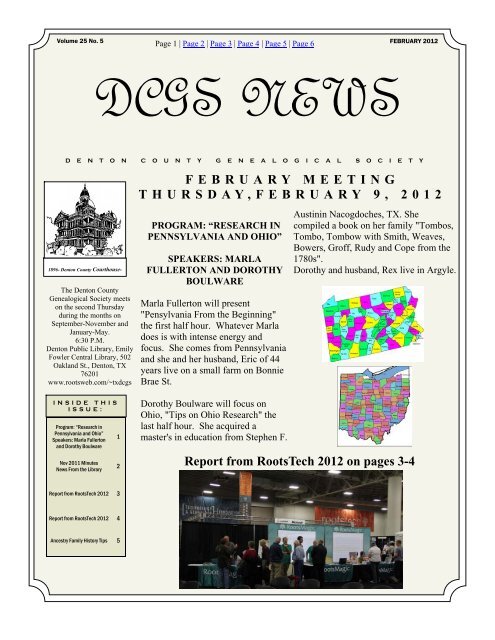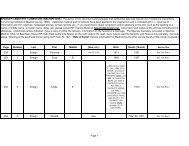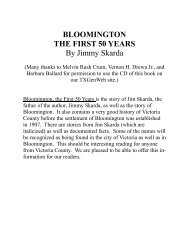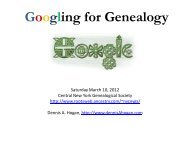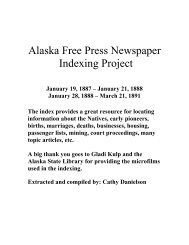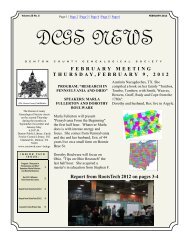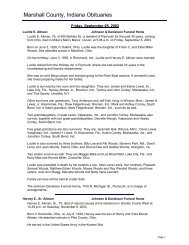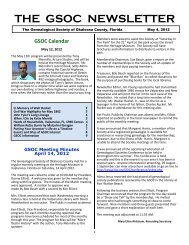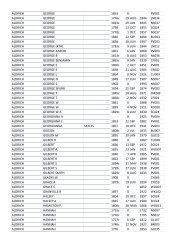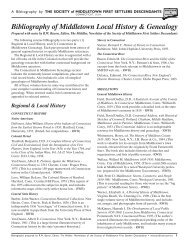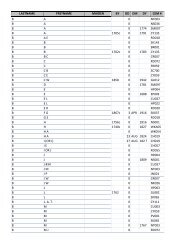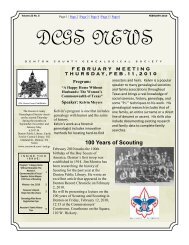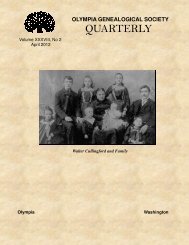DCGS News - RootsWeb - Ancestry.com
DCGS News - RootsWeb - Ancestry.com
DCGS News - RootsWeb - Ancestry.com
You also want an ePaper? Increase the reach of your titles
YUMPU automatically turns print PDFs into web optimized ePapers that Google loves.
Volume 25 No. 5<br />
Page 1 | Page 2 | Page 3 | Page 4 | Page 5 | Page 6<br />
FEBRUARY 2012<br />
<strong>DCGS</strong> NEWS<br />
D E N T O N C O U N T Y G E N E A L O G I C A L S O C I E T Y<br />
FEBRUARY MEETING<br />
THURSDAY,FEBRUARY 9, 2012<br />
1896- Denton County Courthouse-<br />
The Denton County<br />
Genealogical Society meets<br />
on the second Thursday<br />
during the months on<br />
September-November and<br />
January-May.<br />
6:30 P.M.<br />
Denton Public Library, Emily<br />
Fowler Central Library, 502<br />
Oakland St., Denton, TX<br />
76201<br />
www.rootsweb.<strong>com</strong>/~txdcgs<br />
PROGRAM: “RESEARCH IN<br />
PENNSYLVANIA AND OHIO”<br />
SPEAKERS: MARLA<br />
FULLERTON AND DOROTHY<br />
BOULWARE<br />
Marla Fullerton will present<br />
"Pensylvania From the Beginning"<br />
the first half hour. Whatever Marla<br />
does is with intense energy and<br />
focus. She <strong>com</strong>es from Pennsylvania<br />
and she and her husband, Eric of 44<br />
years live on a small farm on Bonnie<br />
Brae St.<br />
Austinin Nacogdoches, TX. She<br />
<strong>com</strong>piled a book on her family "Tombos,<br />
Tombo, Tombow with Smith, Weaves,<br />
Bowers, Groff, Rudy and Cope from the<br />
1780s".<br />
Dorothy and husband, Rex live in Argyle.<br />
INSIDE THIS<br />
ISSUE:<br />
Program: “Research in<br />
Pennsylvania and Ohio”<br />
Speakers: Marla Fullerton<br />
and Dorothy Boulware<br />
Nov 2011 Minutes<br />
<strong>News</strong> From the Library<br />
1<br />
2<br />
Dorothy Boulware will focus on<br />
Ohio, "Tips on Ohio Research" the<br />
last half hour. She acquired a<br />
master's in education from Stephen F.<br />
Report from RootsTech 2012 on pages 3-4<br />
Report from RootsTech 2012 3<br />
Report from RootsTech 2012 4<br />
<strong>Ancestry</strong> Family History Tips 5
Page 2 Page 1 | Page 2 | Page 3 | Page 4 | Page 5 | Page 6<br />
FEBRUARY 2012<br />
JANUARY 2012 MINUTES<br />
Richard Thomas called a full room to order at<br />
7PM. In addition to a good attendance by<br />
members, John Linden and Mary Hunter were<br />
visiting. Leo Burns, Susan Schwartz, and Richard<br />
Schwartz were introduced as our newest members.<br />
Richard announced that members may feel free to<br />
take <strong>DCGS</strong> brochures to distribute and posters to<br />
display. The minutes from November 10,2011,<br />
and financial report were accepted as printed in<br />
the newsletter .<br />
Kathy Strauss suggested we might enjoy the TV<br />
program, “Who Do You Think You Are” which<br />
begins its third season on February 3. There is a<br />
beginning genealogy workshop at our library on<br />
January 28. Several members invested in small<br />
scanners in December and were very pleased with<br />
how well they worked .<br />
Our member, Diana White, gave an excellent<br />
program on “The Peopling of the Old Northwest”.<br />
She emphasized that we should use search engines<br />
more. She made us more aware of the extent of<br />
original colonial grants and how these were later<br />
subdivided to form more states. Diana had maps<br />
showing the settlement of the Old Northwest. She<br />
gave migration routes and the reasons some groups<br />
were migrating in that direction.<br />
Richard adjourned the meeting.<br />
Respectfully submitted,<br />
Cindy Gage<br />
NO TREASURER’S REPORT RECEIVED<br />
NEWS FROM THE LIBRARY<br />
The Denton Public Library will celebrate it’s 75th<br />
Anniversary in 2012. If any of you have interesting<br />
stories, pictures, or artifacts for us to use during our<br />
celebration, please contact the Special Collections<br />
Department at Emily Fowler Library, 502 Oakland<br />
Street, Denton, TX 76201, 940-349-8752.<br />
Genealogy and Local History Programs<br />
Navigating <strong>Ancestry</strong> Library Edition<br />
Learn how to search the largest collections of<br />
genealogical records on the web. Take a tour through<br />
<strong>Ancestry</strong>’s many databases, learn searching<br />
techniques to use when looking for “hard to find”<br />
ancestors.<br />
02/11/2012 Emily Fowler Library 10:00 am-12:00<br />
pm<br />
02/09/12 “A Research in Pennsylvania and Ohio”<br />
Presented by Marla Fullerton & Dorothy Boulware<br />
Emily Fowler Library 6:30 pm-8:30 pm
Page 3 Page 1 | Page 2 | Page 3 | Page 4 | Page 5 | Page 6<br />
FEBRUARY 2012<br />
Report from RootsTech 2012 (2-4 February, 2012, Salt Lake City, Utah)<br />
Dr. Christopher E. Strauss and Kathleen G. Strauss<br />
Last week we attended the second annual<br />
RootsTech conference in Salt Lake City, a gathering<br />
of over 4,200 genealogists and technologists for<br />
three days of high-intensity interaction. There were<br />
very high-quality sessions for Users like us – as<br />
good or better than anything we have experienced at<br />
FGS or other similar conferences, and a parallel<br />
track for Developers of genealogy applications and<br />
databases. We limited ourselves to the User track,<br />
and still could not cover every session that we<br />
wanted to hear between the two of us. The keynote<br />
speeches were exceptional, and challenged us to<br />
think way outside the box about the future of<br />
technology-enhanced genealogy.<br />
The new President and CEO of FamilySearch,<br />
Dennis Brimhall, reported that they are now able to<br />
create an 80 gb digital file from a single roll of<br />
microfilm in only 4 minutes, breaking it up into<br />
separate page images ready for the 100,000+<br />
indexers. They now hope to be able to digitize ALL<br />
of their 2.4 million rolls of microfilm in less than 10<br />
years, instead of the 100 years originally predicted.<br />
He then introduced the outgoing President and<br />
CEO of FamilySearch, Jay Verkler, who described<br />
genealogy research as our descendants might<br />
experience it by the year 2060. He pointed out that<br />
we may have 9.5 billion people on the planet by<br />
then, 7 billion of whom may be researching the 6<br />
billion ancestors born between 1750 and 1900, the<br />
primary domain of genealogical records. Jay then<br />
presented a new model for a <strong>com</strong>munity framework<br />
for recording genealogical data that is entirely<br />
possible in the near future, with incredible<br />
possibilities for collaboration and information<br />
exchange between genealogists. He also described a<br />
new GEDCOM format and application<br />
programming interface (API), and new tools that<br />
Google techs already have working (and were able<br />
to demo) after they attended RootsTech 2011.<br />
The second keynote was just as mind-bending with<br />
Josh Coates, who is a storage researcher and<br />
successful entrepreneur. He talked first about the<br />
history of social networks; beginning with the<br />
telegraph, which spanned the globe by 1891, all the<br />
way past Facebook to whatever <strong>com</strong>es next. Then he<br />
delved into many different concepts of data storage<br />
that are almost in<strong>com</strong>prehensible, and made them<br />
easy to understand. Finally, he explained the “cloud”<br />
in the simplest of terms, and discussed what it might<br />
mean for us. It was VERY entertaining.<br />
For the <strong>Ancestry</strong>.<strong>com</strong> users, the final keynote was by<br />
CEO Tim Sullivan and some of his staff, describing<br />
the future of their services and answering questions<br />
previously submitted by attendees. If any of this<br />
interests you, the keynotes and much more video is<br />
available at http://rootstech.org (22 hours of it – all of<br />
the sessions held in the same theater as the keynotes).<br />
Some of the concepts and ideas in these keynotes<br />
may really surprise you! In particular, I re<strong>com</strong>mend<br />
watching Barbara Renick’s session: “Eleven Layers<br />
of Online Searches” at about the 7:40:00 mark on the<br />
Thursday Recap video stream.<br />
After each keynote, the rest of the day was a<br />
scramble to see the vendors in the exhibit hall, and to<br />
find a seat in the often over-crowded sessions to hear<br />
presentations such as “Using Android devices for<br />
genealogy and family history,” “New avenues in
Page 4 Page 1 | Page 2 | Page 3 | Page 4 | Page 5 | Page 6<br />
FEBRUARY 2012<br />
genetic genealogy,” or “Everything you wanted to<br />
know about Fold3.” There were workshops such as<br />
“The FamilySearch Wiki as social media,” and<br />
ticketed luncheons sponsored by FGS, NGS, NEHGS,<br />
and several of the big content providers that included<br />
very interesting speakers. Wherever we went,<br />
whatever we listened to, we learned something new<br />
about genealogy technology. Not all of it was futurespeak;<br />
some of the tools are available for use today.<br />
The exhibit hall was always busy, with crowds of<br />
users learning how to help index the 1940 census, and<br />
others watching demos of Family Tree Maker, the new<br />
FamilySearch, RootsMagic, or almost any other<br />
application or service available to genealogists. There<br />
was a long line at the FlipPal scanner booth to watch<br />
demonstrations of the product, followed by another<br />
long line several booths to the left at Family Roots<br />
Publishing. There, attendees were buying scanners,<br />
carrying bags, window protectors, and the new Sketch<br />
kit as fast as the folks in the booth could invoice them!<br />
The Sketch kit allows you to overlay a caption on a<br />
picture you want to scan by using a dry erase marker<br />
on a clear plastic sheet. Genealogist Susan Farrell<br />
Bankhead has re-created a virtual Exhibit Hall for you<br />
to browse online, on her blog, at http://<br />
www.susansgenealogyblog.<strong>com</strong>/2012/02/07/your-own<br />
-virtual-exhibit-hall-my-rootstech-recreation/ .<br />
Thanks, Susan!!<br />
After watching a presentation on the new autosomal<br />
DNA testing by Family Tree DNA, which they call<br />
Family Finder, we joined the throngs of people lined<br />
up at their booth to upgrade the testing that we already<br />
have on file for several of our own ancestors. This test<br />
promises to add an entirely new dimension to the use<br />
of DNA in genealogical research. In other DNA news,<br />
<strong>Ancestry</strong>.<strong>com</strong> kept making very loud noises about<br />
some sort of new DNA integration services of their<br />
own. I hope that this addition to ancestry will allow<br />
the entry of data from all of the existing labs that have<br />
been testing for over a decade now, or else<br />
genealogists who have already invested hundreds of<br />
dollars in previous testing are unlikely to receive the<br />
new service favorably. We shall see, once they<br />
actually implement it.<br />
On Friday night, the Family History Library held<br />
extended hours for us until midnight, with pizza to<br />
boot. Saturday concluded with more exceptional<br />
workshops and sessions, and I attended a luncheon<br />
where one of the NEHGS staff described in detail<br />
which tools it was using to digitize, OCR, index,<br />
and publish to their web an average of one new<br />
database every week. That was very impressive,<br />
and a reminder that you have to keep returning to<br />
search the online databases frequently since the<br />
hosting institutions and <strong>com</strong>panies are adding new<br />
content continuously. Overall, it was an<br />
exceptional conference, and we can re<strong>com</strong>mend it<br />
to anyone interested in using technology to enhance<br />
his or her genealogical research. Mark your<br />
calendars now for March 21-23, 2013, in Salt Lake<br />
City.<br />
Pictures were taken at the end of the conference, Saturday,<br />
during the last program session, so you can actually see the<br />
booths and displays without the usual crowds of people.
Page 5 Page 1 | Page 2 | Page 3 | Page 4 | Page 5 | Page 6<br />
FEBRUARY 2012<br />
ANCESTRY FAMILY HISTORY TIPS<br />
Check More Recent Records<br />
My great-grandparents died in the late 1920s-early 1930s in<br />
Keithville, Caddo Parish, Louisiana. I went to the Shreveport<br />
Louisiana Courthouse in hopes of finding a probated will.<br />
Unfortunately the probate records were not <strong>com</strong>puterized back<br />
that far. However, the clerk was kind enough to do a search for<br />
John Patrick Walton and much to my delight she hit gold. My<br />
great-grandparents estate was probated in August 1964—thirtysix<br />
years after my great-grandfather died and thirty-two years<br />
after my great-grandmother. The probate record has been a gold<br />
mine of information. It mentions children that died in infancy<br />
that none of my living family knew about. Now with everything<br />
<strong>com</strong>puterized, do yourself a favor and search the older ancestors<br />
in the newer records just in case there is a hidden gem out there.<br />
Elaine Walton Lewis, Conroe, Texas<br />
Funeral Homes<br />
Funeral Homes are a great source of information. I knew my<br />
great-grandfather, Milton Folger Bray, died between 1920 and<br />
1930 either in Virginia or North Carolina. Virginia is a difficult<br />
state to get vital records from. So I looked up funeral homes in<br />
the area where he last lived in and started calling. The first one I<br />
called told me which funeral home would have been in business<br />
in that time period. I called them, left information, and asked<br />
them for their assistance at their convenience. Ten minutes later<br />
they called me back. They had done his funeral services and<br />
gave me detailed information on his family and his death that<br />
wasn't on his death certificate or in his obituary. Although some<br />
people find funeral homes a little morbid, they are my<br />
genealogical friends. Michelle Landers<br />
Siblings' Death Records<br />
Be sure to cross-check the death certificates of your ancestor’s<br />
siblings. My great-grandfather's mother was a mystery. Her first<br />
name had been listed as Eleanor, Elender, and Elvira in different<br />
census records. There was also a question about her last name.<br />
Unfortunately, the death certificate of my great-grandfather was<br />
hard to read. I couldn't make out his mother's name with<br />
certainty. So I looked for his siblings' death certificates and<br />
<strong>com</strong>pared them all to figure it out. Now I search and save death<br />
certificates of all siblings. It's also helpful in making sure I<br />
have the right brothers and sisters listed.<br />
Cindy Lee<br />
Copy the Entire Page<br />
When writing or visiting a county clerk's office for a<br />
record, I ask for a copy of the entire page, not just a<br />
certified copy. I found that strikeouts in the original record<br />
can tell a lot more than whether the recorder was accurate.<br />
"Originals" may not be the first record, as in a case in<br />
Western Virginia where the recorder apparently had put<br />
information pertaining to my ancestor's death into one<br />
book, and then transcribed it into a record (<strong>com</strong>plete with<br />
strikeouts and corrections) that went to Richmond at the<br />
end of the year. Marilyn Steber, San Diego<br />
Commonwealth War Graves<br />
As someone with family roots in England, I have frequently<br />
(and sadly) <strong>com</strong>e across relatives who bravely gave their<br />
lives in the First World War. For other family history<br />
researchers who have identified military personnel from<br />
Commonwealth countries who died in both World Wars, I<br />
highly re<strong>com</strong>mend the website of the Commonwealth War<br />
Graves Commission at www.cwgc.org.<br />
The <strong>com</strong>mission is responsible for maintaining the military<br />
cemeteries for most Commonwealth countries (the U.K.,<br />
Canada, Australia, New Zealand, etc.) in Europe and<br />
around the world. Their records list every fallen service<br />
person individually and are fully searchable, allowing<br />
researchers to identify in which cemetery a family member<br />
was laid to rest or where those whose remains were never<br />
found are <strong>com</strong>memorated. The site has extensive<br />
information about each cemetery and directions for visiting<br />
if one were able to do that, as well as other educational<br />
resources. Every November we remember those who<br />
sacrificed their lives to maintain our liberties. This site<br />
affords a further opportunity to illuminate their histories.<br />
Barry Buckler, Markham, Ontario<br />
2009-2010 OFFICERS<br />
President—E. Richard Thomas<br />
Vice-President—Dayonne Work<br />
Secretary—Cynthia Gage<br />
Treasurer—Holly Hervey<br />
Librarian—Kathy Strauss<br />
Webmaster—Chris Strauss<br />
Parliamentarian—Vickie Davis<br />
NEXT MEETING OF THE<br />
DENTON COUNTY<br />
GENEALOGICAL<br />
SOCIETY WILL BE ON<br />
MARCH 8, 2012<br />
Emily Fowler Central<br />
Library<br />
502 Oakland St.<br />
Denton
Page 1 | Page 2 | Page 3 | Page 4 | Page 5 | Page 6<br />
D E N T O N C O U N T Y<br />
G E N E A L O G I C A L S O C I E T Y<br />
502 Oakland Street<br />
Denton, TX 76201


